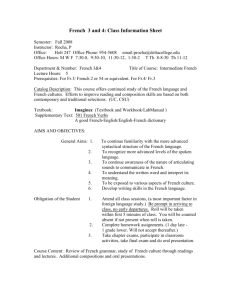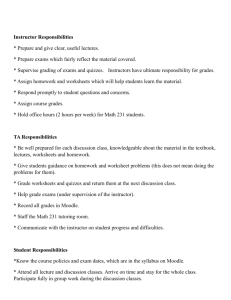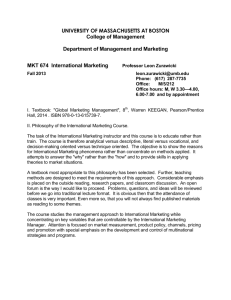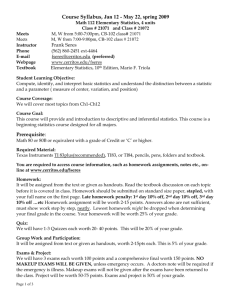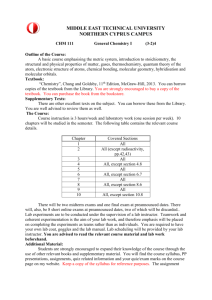Statistical Methods in Education Syllabus, Spring 2013
advertisement
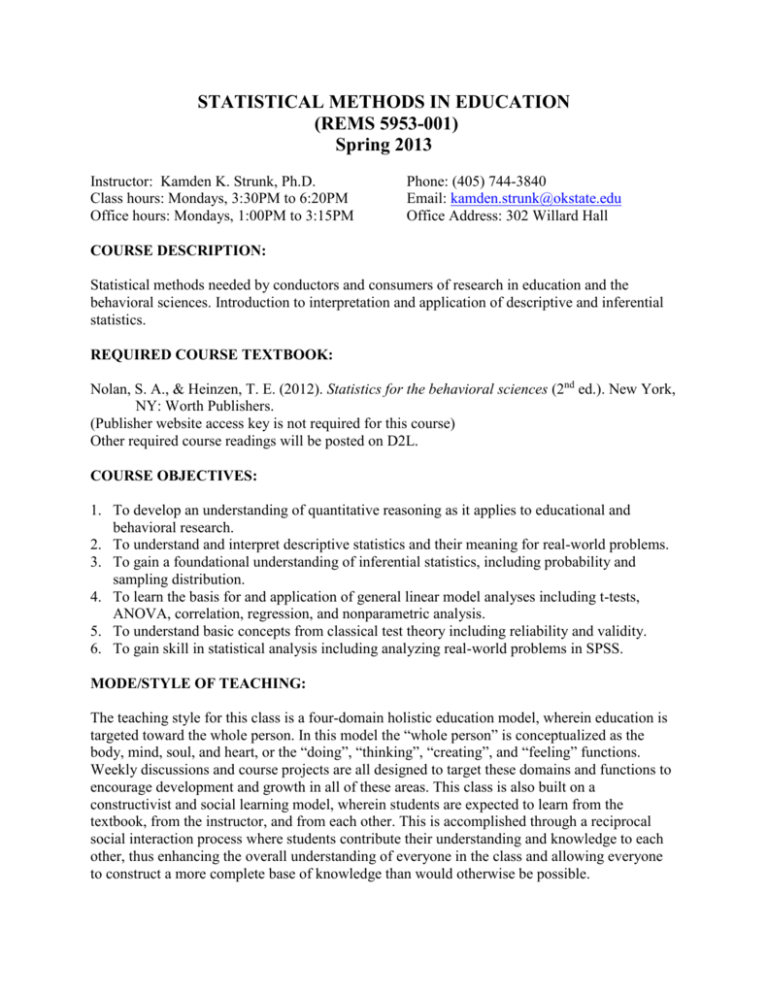
STATISTICAL METHODS IN EDUCATION (REMS 5953-001) Spring 2013 Instructor: Kamden K. Strunk, Ph.D. Class hours: Mondays, 3:30PM to 6:20PM Office hours: Mondays, 1:00PM to 3:15PM Phone: (405) 744-3840 Email: kamden.strunk@okstate.edu Office Address: 302 Willard Hall COURSE DESCRIPTION: Statistical methods needed by conductors and consumers of research in education and the behavioral sciences. Introduction to interpretation and application of descriptive and inferential statistics. REQUIRED COURSE TEXTBOOK: Nolan, S. A., & Heinzen, T. E. (2012). Statistics for the behavioral sciences (2nd ed.). New York, NY: Worth Publishers. (Publisher website access key is not required for this course) Other required course readings will be posted on D2L. COURSE OBJECTIVES: 1. To develop an understanding of quantitative reasoning as it applies to educational and behavioral research. 2. To understand and interpret descriptive statistics and their meaning for real-world problems. 3. To gain a foundational understanding of inferential statistics, including probability and sampling distribution. 4. To learn the basis for and application of general linear model analyses including t-tests, ANOVA, correlation, regression, and nonparametric analysis. 5. To understand basic concepts from classical test theory including reliability and validity. 6. To gain skill in statistical analysis including analyzing real-world problems in SPSS. MODE/STYLE OF TEACHING: The teaching style for this class is a four-domain holistic education model, wherein education is targeted toward the whole person. In this model the “whole person” is conceptualized as the body, mind, soul, and heart, or the “doing”, “thinking”, “creating”, and “feeling” functions. Weekly discussions and course projects are all designed to target these domains and functions to encourage development and growth in all of these areas. This class is also built on a constructivist and social learning model, wherein students are expected to learn from the textbook, from the instructor, and from each other. This is accomplished through a reciprocal social interaction process where students contribute their understanding and knowledge to each other, thus enhancing the overall understanding of everyone in the class and allowing everyone to construct a more complete base of knowledge than would otherwise be possible. COURSE ASSIGNMENTS: 1. Projects: There are five projects in the class. Projects will consist of SPSS data analysis, interpreting results, and answering questions about the statistical analysis. These projects are designed to deepen your understanding of the statistical methods through practice using them on applied problems and thinking through how the statistics learned in class apply to educational research. Projects are worth 100 points each. 2. Exams: There are five exams in this course. Each exam is over readings, lecture, and assignments from the preceding sections of the class. Exams are to be taken individually, without the assistance of the textbook, internet, or the help of other people. Any use of the textbook, assistance from a classmate or another individual, or use of the internet on the exams will be treated in accordance with the OSU Academic Integrity policy. All exams are due prior to the beginning of class, with the exception of the Final Exam, which is administered in class, and will be comprehensive. Each of the first four exams are worth 50 points, and the final exam is worth 100 points. 3. Article Reviews: You will complete six article reviews. You will select one article that uses t-test, one that uses ANOVA or ANCOVA, one that uses correlation or regression, and one that uses nonparametric or categorical analysis for your article reviews. Choose articles that apply to your area of interest, as this will help make the assignment more interesting. For these ‘method’ articles, you will review the article, their use of the method, and critique their results in approximately 2-3 pages. Then, two article reviews are articles your instructor has selected to enrich your understanding of statistics and measurement, and your review of those articles will review the content as well as critiquing their argument and how it might apply to your field of study. Each article review is worth 25 points 4. News Critique: You will find one story in the print news that is based on empirical research. Critique their use of that research, the statistics within, and how it is presented. Is their presentation of the results consistent with what you know given your ability to read and interpret statistics? Is it misleading? Have they considered the limitations of the study? Critique the presentation of the research. Choosing a news story related to your career field is recommended. 5. Research Participation: As researchers, we often ask individuals to participate in our research. As such, it is incumbent on us to participate in the research of our colleagues. A requirement in this course is that you complete 2.5 units of research participation through the College of Education Sona system (http://okstate-coeosu.cona-systems.com/). You have automatically been added to the Sona system as a result of your enrollment in this course. If you for any reason do not wish to participate in human subjects research, contact the course instructor for an alternative assignment such as writing a research review or attending research seminars and writing about those experiences. Your instructor may also try to arrange for researchers to visit the class to expose you to various forms of research, and help you fulfill this requirement. This assignment is worth 25 points. EXTRA CREDIT: You may gain 25 extra credit points in the course by completing 2.5 additional Sona credits beyond the required 2.5. GRADING STRUCTURE/REQUIREMENTS: There are a total of 1000 points in the course, which means you can take your total points and divide by ten to determine your percentage grade in the course. The grading structure is as follows: Assignment Type Total Points Possible Projects 500 points Exam One 50 points Exam Two 50 points Exam Three 50 points Exam Four 50 points Final Exam 100 points Article Reviews 150 points News Critique 25 points Research Participation 25 points TOTAL POINTS 1000 points The course is graded as follows: A = 100-90%, B = 89.99%-80%, C = 79.99%-70%, D = 69.99%-60%, F < 60%. Therefore, an A is a final course grade ranging from 900-1000 points, a B is a final course grade ranging from 800-899 points, a C is a final course grade ranging from 700-799 points, a D is a final course grade ranging from 600-699 points, and an F is a final course grade of 599 points or less. CLASS PREPAREDNESS: Students are expected to arrive to class on time and prepared for required coursework. This means arriving prepared for in-class activities that may require the use of the textbook, spare paper, and a basic calculator. You should bring a calculator, the course textbook, and paper with you to each class period to be prepared for in-class activities designed to strengthen conceptual understanding. LATE WORK POLICY: Late work is not acceptable in graduate work. However, if you find that you are falling behind in your coursework, it is of the utmost importance that you immediately contact your instructor. As soon as you know there is any problem, immediately contact the course instructor. This is the best way to stay caught up with the course, and to achieve the highest possible grade. If you find that you need to submit late work it is required that you contact the instructor before submitting any late work. Any late work submitted without first contacting the instructor to discuss the work and form a plan for getting caught up to date with coursework will not be accepted. This is to make sure that you receive all information you need about which assignments will take priority in getting caught up, and what, if any, credit can be given to late work before beginning. Communication is the key in getting caught up if you find yourself behind on work, so call, email, or stop by, whatever you need to do to get in contact! TENTATIVE COURSE CALENDAR: Week 1 1/7/13 2 1/14/13 3 1/21/13 4 1/28/13 5 2/4/13 6 2/11/13 7 2/18/13 8 2/25/13 9 3/4/13 10 3/11/13 11 3/18/13 12 3/25/13 13 4/1/13 14 4/8/13 Readings Chapter 1 & Handout (Furr & Bacharach) Chapter 2 &3 Content Introductions; Constructions and Measurement Assignments Statistical Reasoning University Holiday – NO CLASS Chapter 4 Central Tendency and Variability Chapter 5 &6 Chapter 7 &8 Chapter 9, 10, & 11 Chapter 9 & 10 Chapter 11 Normal Curve/Standardization Review of Cohen (1994) due Project One Due Statistical Significance EXAM ONE DUE Power, Effect Size, Confidence Intervals Review of Article (TBA) due T-tests T-test article review due Chapter 12 & 13 Analysis of Variance Project Two Due EXAM TWO DUE T-tests University Holiday – NO CLASS Chapter 14 Analysis of Variance Chapter 15 Correlation and Regression Chapter 16 Correlation and Regression 15 4/15/13 Chapter 17-18 Nonparametric Statistics 16 4/22/13 17 4/29/13 TBA Reliability and Validity ANOVA article review due Project Three Due EXAM THREE DUE Correlation or Regression article review due Nonparametric article review due Project Four Due EXAM FOUR DUE Project Five Due FINAL EXAM News critique due Note. All readings other than the textbook can be found on D2L listed under the name of that week’s topic. POSSIBLE CHANGES TO THE SYLLABUS: “This syllabus is your contract for production in the course. If changes are made to it they will be posted on Desire 2 Learn. No changes increasing requirements will be made as they might adversely affect your grade.” ADDITIONAL INFORMATION AND RESOURCES: Academic Integrity: “I will respect OSU’s commitment to academic integrity and uphold the values of honesty and responsibility that preserve our academic community.” Oklahoma State University is committed to the maintenance of the highest standards of integrity and ethical conduct of its members. This level of ethical behavior and integrity will be maintained in this course. Participating in a behavior that violates academic integrity (e.g., unauthorized collaboration, plagiarism, multiple submissions, cheating on examinations, fabricating information, helping another person cheat, unauthorized advance access to examinations, altering or destroying the work of others, and fraudulently altering academic records) will result in your being sanctioned. Violations may subject you to disciplinary action including the following: receiving a failing grade on an assignment, examination or course, receiving a notation of a violation of academic integrity on your transcript (F!), and being suspended from the University. You have the right to appeal the charge. Contact the Office of Academic Affairs, 101 Whitehurst, 405-744-5627, academicintegrity.okstate.edu. Refer to the Contents Section for these additional course documents: 1. Oklahoma State University Syllabus Attachment Spring 2013 http://osu.okstate.edu/acadaffr/aa/syllabusattachment-Spring.htm 2. Oklahoma State University Office of the Registrar Enrollment Guide Spring 2013.
